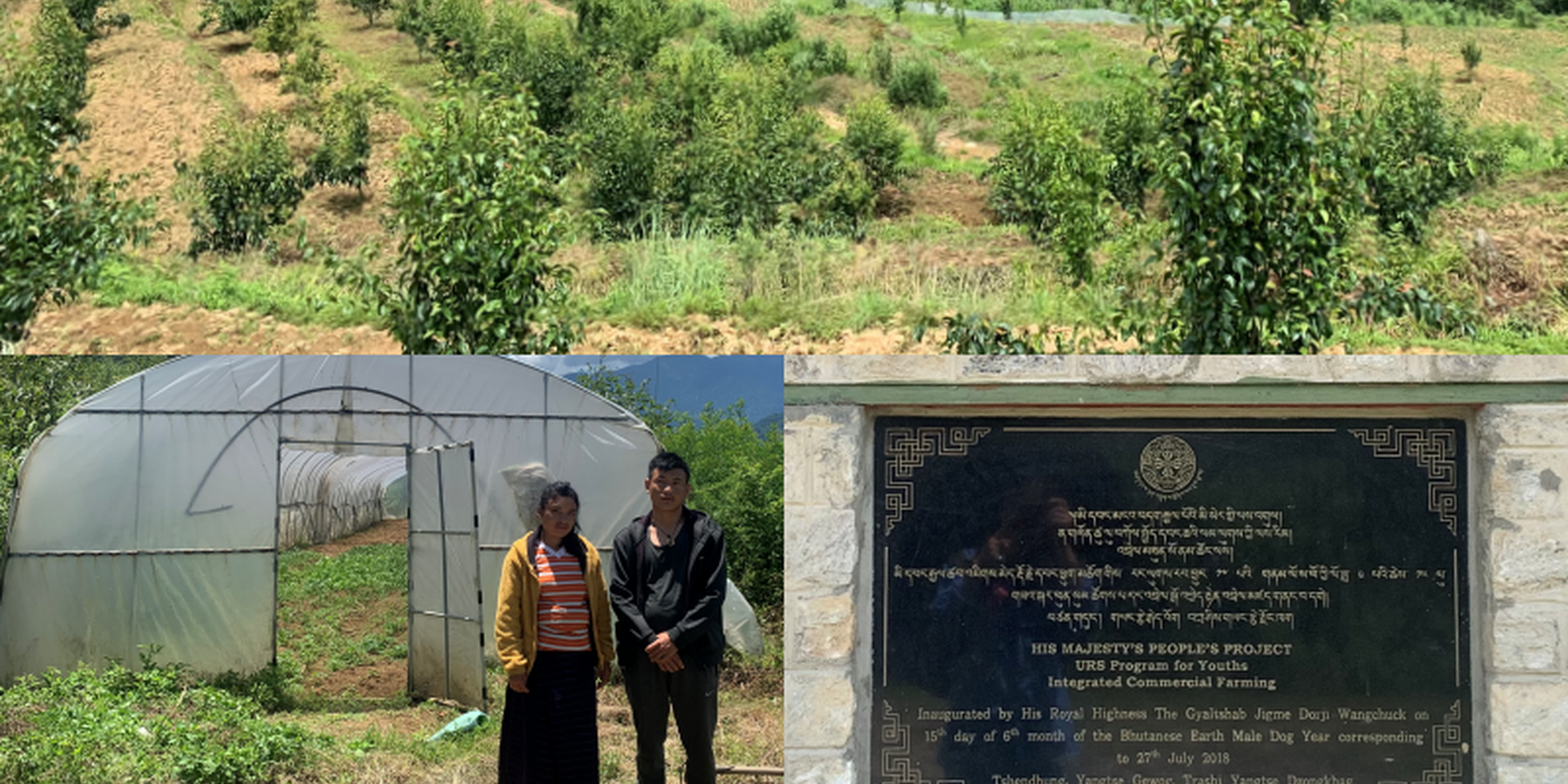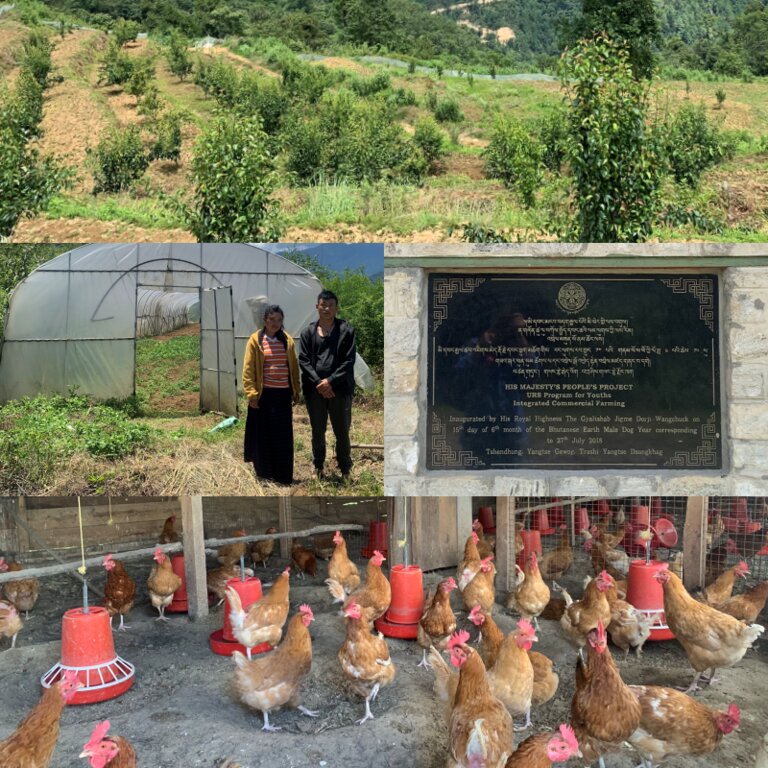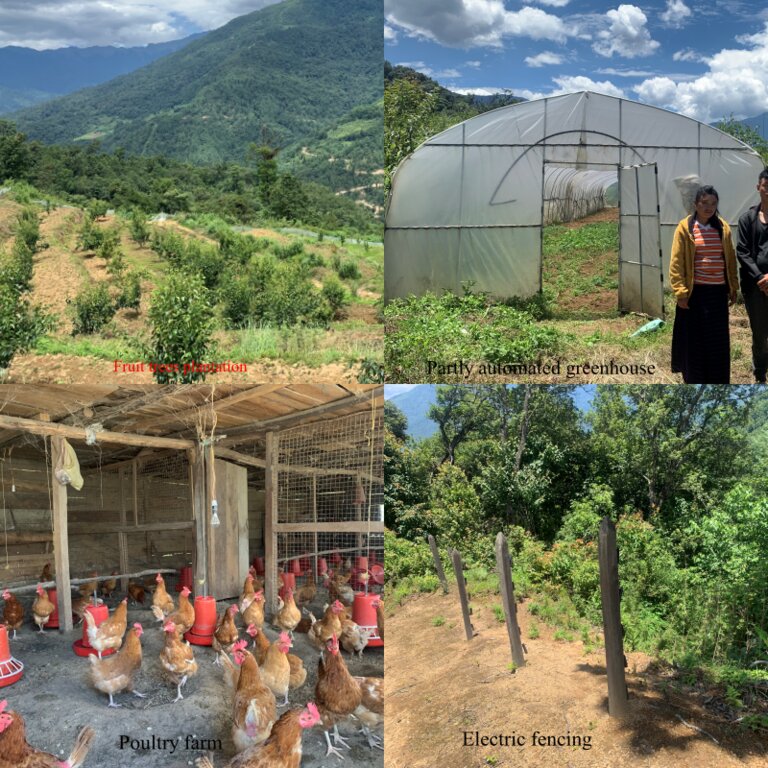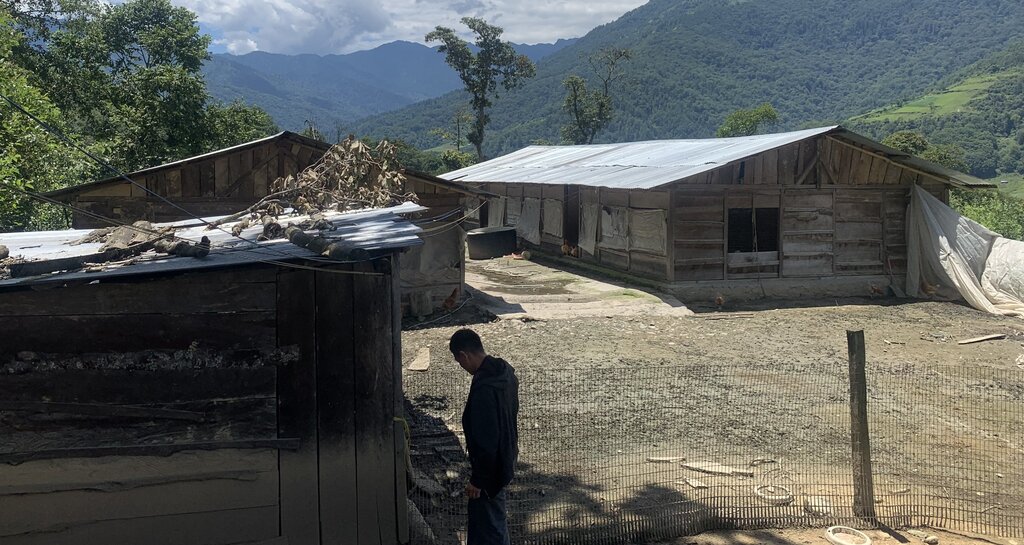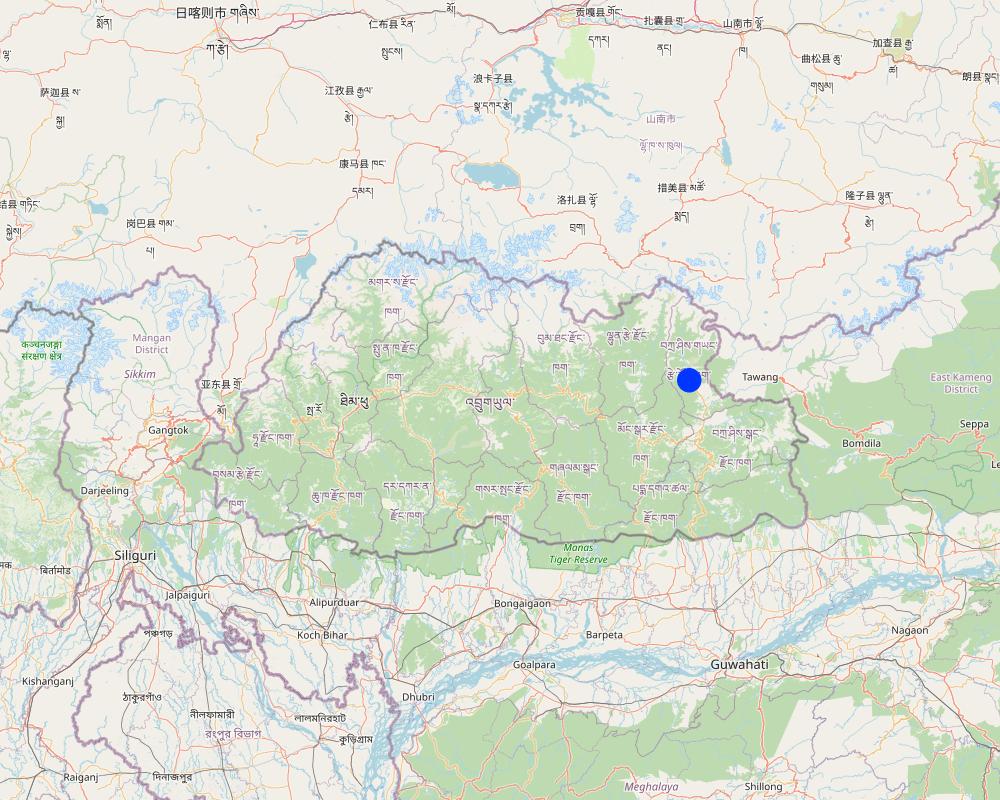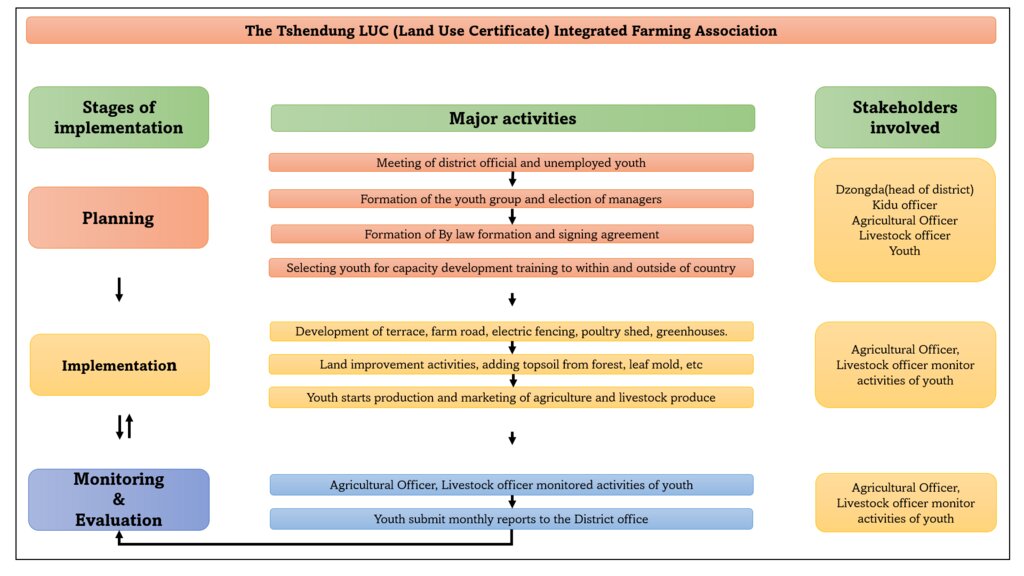Land Use Certificate to engage youth in Agriculture [Бутан]
- Создание:
- Обновить:
- Составитель: ONGPO LEPCHA
- Редактор: chenga Tshering
- Рецензенты: William Critchley, Rima Mekdaschi Studer
'Sa cha Kelchay Lakher'
approaches_6886 - Бутан
Просмотреть разделы
Развернуть все Свернуть все1. Общая информация
1.2 Контактные данные специалистов и организаций, участвующих в описании и оценке Подхода
Ответственный (-ые) специалист (-ы)
землепользователь:
Tenzin Kuenzang
17582178
Tshendung, Lichen Chiwog, Yangtse gewog
Бутан
землепользователь:
Wangmo Sither
17459445
Tshendung, Lichen Chiwog, Yangtse gewog
Бутан
Название проекта, содействовавшего документированию/оценке Подхода (если применимо)
Strengthening national-level institutional and professional capacities of country Parties towards enhanced UNCCD monitoring and reporting – GEF 7 EA Umbrella II (GEF 7 UNCCD Enabling Activities_Umbrella II)Название организации (-ий), содействовавших документированию/оценке Подхода (если применимо)
National Soil Services Centre, Department of Agriculture, Ministry of Agriculture & Livestock (NSSC) - Бутан1.3 Условия, регламентирующие использование собранных ВОКАТ данных
Когда были собраны данные (на местах)?
19/07/2023
Составитель и ответственный/-ые специалист(-ы) согласны с условиями, регламентирующими использование собранных ВОКАТ данных:
Да
2. Описание Подхода УЗП
2.1 Краткое описание Подхода
The Land Use Certification (LUC) commenced in 2015 as the new allocation system for land and provided a new title of land tenure. Initially, LUC focused on allotting land to Government institutions and Gerab Dratshang (monastic bodies). However, LUC later focused on the unemployed youth who were interested in commercial farming.
2.2 Подробное описание Подхода
Подробное описание Подхода:
The Land Use Certification (LUC) commenced in 2015 as the new system for the allocation of land and a new title of land tenure. Initially, LUC focused on allotting land to Government institutions and Gerab Dratshang (monastic bodies). However, LUC later focused on the unemployed youth who were interested in commercial farming. This documentation is based on the LUC group ‘Tshendung LUC Integrated Farming Association'.
The main aims of the LUC approach are 1) to help sustainably manage and enhance productive use of land, 2) to encourage next-generation farming through farm mechanization and large-scale enterprising farming, and 3) to enhance the rural economy.
The approach started as an initiative towards the realization of the noble vision of strengthening sovereignty and security and enhancing social policy of equity and the national objective of self-reliance. Unemployed youth groups are expected to help sustainably manage and enhance the productive use of land - and the approach was to encourage next-generation farming through farm mechanization and large-scale production to promote enterprise-based farming and enhance the rural economy. Initially, it started with a meeting between district officials and unemployed youth. Later, bylaws were created, and agreements were signed. This was followed by sending youth for capacity development within and outside the country. They were trained on how to operate power tillers, use grass cutters and chain saws, and on the installation of electric fencing and greenhouses. In addition, they were trained in how to grow vegetables, fruit crops, and livestock production. In parallel infrastructure development activities were taking place in the current project sites.
The Tshendung LUC Integrated Farming Association enables land users to carry out agricultural activities more effectively. In addition, the association was able to transport and market their produce more efficiently than individual households. Other co-benefits reported are the improved community sense and enhanced social cohesion because the exchange of experiences and collaboration builds mutual trust. Working in a group eases hard physical work on the 9 acres (3.6 ha) of land.
The District Office initiated the group formation upon command from higher authority. They were also involved in planning, forming groups, bylaws, and monitoring the activities of the group. The District agricultural and livestock officers provided technical guidance on crop and livestock production. They also provided them with agricultural inputs. Lichen Primary School are consumers of the agricultural and livestock goods produced by the group. Land users are involved in planning the production and marketing of agricultural and animal products.
Initially, there were 11 youths in the group. They were provided with wide-ranging training and support including the preparation of land for growing crops and the construction of their residence. In addition to agricultural inputs like seeds, and saplings, the group was also provided farm machinery and farm tools for easy implementation of farm works. The group is happy with all the initiatives the government has done, however, one thing that discouraged the group from continuing with farming activities was the location of the site. They didn't like the location - which is in the middle of the forest around 15-20km away from the town. This makes transportation of agricultural inputs like seeds and feeds and marketing of agricultural and livestock products very difficult. The government initially supported the group with everything but later this support was withdrawn, which made it very difficult for the group to survive on their own.
2.3 Фотографии, иллюстрирующие Подход
2.5 Страна/ регион/ место, где применялся Подход
Страна:
Бутан
Административная единица (Район/Область):
Lichen, Trashi Yangtse: Bhutan
Более точная привязка места:
Tshendung, Lichen chiwog (village), Yangtse gewog (sub district): Trashi Yangtse Dzongkhag (District)
Map
×2.6 Даты начала и окончания реализации Подхода
Год начала реализации:
2015
Если год начала реализации Подхода достоверно неизвестен, дайте примерную оценку:
менее 10 лет назад (недавняя)
Комментарии:
The Land Use Certification (LUC) is an initiative commenced in 2015 as the new allotment system of land and a new title of land tenure.
2.7 Тип Подхода
- недавняя местная инициатива/ инновация
2.8 Каковы цели/ задачи Подхода
The main aims/objectives of the approach are to 1) foster youth entrepreneurship in the country, 2) promote, foster, encourage, and assist the efficient, convenient marketing and distribution of agricultural products, livestock, and associated by-products with the growing market within Trashi Yangtse and other districts in the country.
2.9 Условия содействующие применению Технологии/ Технологий в рамках Подхода или затрудняющие его
Социальные/ культурные/ религиозные нормы и ценности
- содействуют
Land users are generally from the same local ethnic groups called Yangtsepa. They shared the same social, cultural, religious, norms and values. Gender equality is considered and importance and priority is given equally.
Наличие/ доступность финансовых ресурсов и услуг
- затрудняют
Initially, land users were provided all required support by the project including financial support, however, when the land users started implementing and working on the approach own their own. Getting financial support was difficult.
Институциональные условия
- затрудняют
Initially, there were 11 land users involved, however, today only two of the land users are active. Shortage of human resources hinders production and this result in low profit.
Сотрудничество/ координация действий
- затрудняют
Although the land users are able to produce a certain quantity of vegetables there are not many collaborators willing to buy their produce. They also lack a farm manager who can dedicate 100% of his time in marketing and finding collaborators.
Осведомленность в области УЗП, доступность технической поддержки
- содействуют
Technical support related to agriculture and livestock is provided by the District Agriculture officer and livestock officers. Inputs like seeds are also freely provided by the district. The activities are also monitored by the officers and advices are given if land users are doing thing wrongly.
Рынки (для приобретения материалов и услуг, продажи продукции) и цены
- затрудняют
The site of the approach is located very far from the market. The size of the market is very small with lots of other competitors like farmers groups i.e., Vegetable group, milk group, etc. And due to this competition, the prices the land users get are very low.
Объем работ, доступность рабочей силы
- затрудняют
Totally, there are about 9 acres of land and there are only two land users who are active and working in the land. The workload is too much and this affects their production.
3. Участие и распределение ролей заинтересованных сторон
3.1 Заинтересованные стороны, участвующие в реализации Подхода и их роли
- местные землепользователи/ местные сообщества
Youth from local communities
They are the land users on the project site.
- эксперты по УЗП/ сельскому хозяйству
District Agriculture and Livestock officers
Advisors: All technical supports related to the production of crops and livestock are provided by these officers.
- учителя/ преподаватели/ школьники / студенты
Lichen Primary School
Consumers: Vegetables produced by the land users are sold to the school.
- государственные власти (отвечающие за планирование или принятие решений)
District head office
Decision makers: provide technical support and financial support. involved in the planning and implementation of the activities under the approach.
3.2 Участие местных землепользователей/ местных сообществ на разных стадиях реализации Подхода
| Участие местных землепользователей/ местных сообществ | Перечислите участников и опишите их вовлеченность | |
|---|---|---|
| инициирование/ мотивация | внешняя поддержка | District officer, Kidu officer directed the youths on the opportunity through this approach. |
| планирование | интерактивное | The district officer, engineer, agricultural and livestock extension officer, head of the gewog/block, and land users identified the place and started the planning. |
| выполнение | интерактивное | The district engineer started the land development activities by creating a terrace and farm road. This was later followed by agricultural and livestock activities. |
| мониторинг/ оценка | интерактивное | Focal person for LUC Agriculture extension officer Livestock extension officer District legal officer |
3.3 Схема реализации (если имеется)
Описание:
Flow chart of the major events that took place before youth started taking care of the land. Also indicates different phase of approach and stakeholders involved.
Автор:
Ongpo Lepcha
3.4 Принятие решений по выбору Технологии/ Технологий УЗП
Укажите, кто принимал решение по выбору применяемой Технологии/ Технологий:
- исключительно землепользователи (по собственной инициативе)
Поясните:
Initially, a part of electric fencing was done by the government, and later the group installed a part of greenhouse. Chicken manure and leaf mould, and top soil from the forest were collected and applied.
Поясните на чём было основано принятие решений:
- личный опыт и мнения (незадокументированные)
4. Техническая поддержка, повышение компетенций и управление знаниями
4.1 Повышение компетенций/ обучение
Проводилось ли обучение землепользователей/ других заинтересованных лиц?
Да
Укажите, кто проходил обучение:
- землепользователи
Если существенно, укажите гендерный и возрастной состав, статус, этническую принадлежность и т.д.
10 males and a female were trained. They were all under the age of 25.
Тип обучения:
- обмен опытом между фермерами
- опытные участки
Рассматриваемые темы:
Production of fruits and vegetables, Poultry and dairy production, Power tiller operation, and record keeping.
Комментарии:
Land users were sent to India for the site visit to explore and learn about poultry production, dairy production, and vegetable and fruit production. Some of them attended training on how to operate power tillers.
4.2 Консультационные услуги
Есть ли у землепользователей возможность получать консультации?
Да
Укажите, где именно оказываются консультационные услуги:
- на полях землепользователей
- в постоянно функционирующих центрах
Описание/ комментарий:
The agricultural extension officer and livestock officer provided advice on what crop to grow, and what livestock to rear.
4.3 Институциональная (организационная) поддержка
В ходе реализации Подхода были ли организованы новые институциональные структуры или поддержаны уже существующие?
- да, умеренно
Укажите уровень, на котором структуры были укреплены или вновь созданы:
- местные
Опишите организацию, функции и ответственность, членство и т.д.
Institutional strengthening between the group and the Lichen Primary School was strengthened. Here the group is a producer of vegetables, butter, and cheese and the school is the buyer.
4.4 Мониторинг и оценка
Являются ли мониторинг и оценка частью Подхода?
Да
Комментарии:
Crop and livestock production were monitored through observation by the agricultural officer and livestock officer.
Если да, будет ли данный документ использоваться для мониторинга и оценки?
Да
4.5 Научные исследования
Были ли научные исследования частью Подхода?
Да
Укажите темы исследований:
- экономика / маркетинг
- технология
Напишите подробнее и назовите тех, кто выполнял исследования:
The research was conducted to study the feasibility of different vegetables in different seasons. Trials were conducted and land users found out that most vegetables don't do well except vegetables like cabbage, beans, and chilli.
5. Финансирование и внешняя материальная поддержка
5.1 Годовой бюджет мероприятий по УЗП в рамках Подхода
Комментарий (например, основные источники финансирования/ ключевые доноры):
There is no budget allocated for any SLM technologies in this approach. All financial needs were met by the project.
5.2 Финансирование и внешняя материальная поддержка, предоставляемая землепользователям
Предоставлялась ли землепользователям финансовая/ материальная поддержка для применения Технологии /Технологий?
Да
Если да, укажите тип(-ы) поддержки, кто ее предоставил и условия предоставления:
Construction support: Road constructed by project, land development done by project
Constructional material support: Electric fencing, housing, Irrigation, greenhouse, power tillers, power chain, grass cutter, wheelbarrow, secateurs, spades, shovels, etc.
5.3 Субсидии на отдельные затраты (включая оплату труда)
- оборудование
| Укажите, какие ресурсы были субсидированы | В какой степени | Опишите субсидии подробнее |
|---|---|---|
| техника | профинансированы полностью | The cost for 3 power tillers, 3 power tillers, 3 grass cutters, and 1 chaffer is all provided by the project for free. |
| инвентарь/ инструменты | профинансированы полностью | Tools like spades, secateurs, shovels, spade, sickle, rake, pruning saw, wheelbarrow, knife, |
- сельскохозяйственные
| Укажите, какие ресурсы были субсидированы | В какой степени | Опишите субсидии подробнее |
|---|---|---|
| семена | профинансированы полностью | Vegetable seeds were provided free by the project |
| удобрения | профинансированы полностью | Suphala were initially provided for free. |
- строительные материалы
| Укажите, какие ресурсы были субсидированы | В какой степени | Опишите субсидии подробнее |
|---|---|---|
| дороги | профинансированы полностью | The cost involved in road and land development was paid by the project. |
| House | профинансированы полностью | All materials used for making house and stores were provided by the project. |
- инфраструктура
| Укажите, какие ресурсы были субсидированы | В какой степени | Опишите субсидии подробнее |
|---|
Если труд землепользователя был существенным вкладом, укажите, был ли этот вклад:
- в обмен на другие материальные ресурсы
Комментарии:
Land users (youth) worked in the group for the installation of the greenhouse, electric fencing, construction of a poultry shed, and apartment bungalow for themselves.
5.4 Кредитование
Предоставлялись ли в рамках Подхода кредиты на мероприятия УЗП?
Нет
5.5 Другие методы или инструменты стимулирования
Использовались ли другие методы или инструменты стимулирования для продвижения Технологий УЗП?
Да
Если да, поясните:
Land development was carried out under the supervision of the District Agricultural and livestock officers, who are SLM experts at the district level. Greenhouses with simi automated irrigation, terraces with bunds, and electric fencing were promoted as incentives through the project.
6. Анализ влияния и заключительные положения
6.1 Влияние Подхода
Сумел ли Подход расширить возможности местных землепользователей, повысить участие заинтересованных сторон?
- Нет
- Да, немного
- Да, умеренно
- Да, существенно
Land users received various training which helped them equip with knowledge and skills related to the use of agricultural machinery like power tillers, grass cutters, and chaffer machines. In addition, they also learned how to grow vegetables and fruits scientifically.
Сумел ли Подход дать возможность принимать решения на основе подтвержденных фактов?
- Нет
- Да, немного
- Да, умеренно
- Да, существенно
Land users initially practiced growing crops based on the local communities, however, later they learned to do off-season vegetables using a greenhouse, and the vegetables they grew were all based on the evidence that some vegetables are not doing good in the location.
Сумел ли Подход помочь землепользователям внедрить и поддерживать технологии УЗП?
- Нет
- Да, немного
- Да, умеренно
- Да, существенно
The site of the approach is located away from local communities. Using technologies like electric fencing became very important. The land user also shared their view on aspects and slopes of the land and their activities like maintaining the slope and fertility of the land. Land user also added that they were taught how to grow Napier grass to reduce land degradation.
Сумел ли Подход расширить знания и возможности землепользователей в применении практик УЗП?
- Нет
- Да, немного
- Да, умеренно
- Да, существенно
Land users received various training which helped them equip with knowledge and skills related to the use of agricultural machinery like power tillers, grass cutters, and chaffer machines. In addition, they also learned how to grow vegetables and fruits scientifically. This knowledge and skills indirectly helped them to maintain soil fertility and increase production.
Сумел ли Подход расширить возможности социально и экономически уязвимых групп?
- Нет
- Да, немного
- Да, умеренно
- Да, существенно
Land users were mostly unemployed youths from nearby villages. They were sons and daughters of socially and economically disadvantaged groups. Some of them had an educational background and some never went to school. The approach have empower this youth very much in term of knowledge and skills.
Сумел ли Подход стимулировать молодежь/ будущее поколение землепользователей заниматься УЗП?
- Нет
- Да, немного
- Да, умеренно
- Да, существенно
Land users were mostly youth between the age group of 20 to 30. This indicates that the approach has encouraged young people to engage in SLM.
Сумел ли Подход привести к созданию новых рабочих мест/ к расширению возможностей получения дохода?
- Нет
- Да, немного
- Да, умеренно
- Да, существенно
It was learned that initially when this approach first started there were around 20 youths involved. Many youths have left the group after they have improved their skills and knowledge through the approach. Today many of them have their own farm and business.
6.2 Основные причины, побуждающие землепользователей внедрять УЗП
- рост продуктивности
The land user shared that increased agricultural production through the approach motivated them the most. More production means more money for the youth.
- материальное стимулирование/ субсидии
More than the production, payments/subsidies motivated them the most. The project supported them from land preparation to providing capacity development through training and site visits to some international sites.
6.3 Долгосрочная устойчивость мероприятий в рамках Подхода
Могут ли землепользователи самостоятельно (без внешней поддержки) продолжать применение того, что было реализовано в рамках Подхода?
- нет
Если нет или нет уверенности, объясните почему:
Initially, many land users were involved in sustaining and implementing the approach. However, later many land users could not continue to be part of the approach. In this case, the present land user said that in the future it will be very difficult to sustain what has been implemented through the approach. This is mainly because different land users were trained in different aspects of the approach. Secondly, the less number of land users involved cannot look after a huge area i.e., 9 acres.
6.4 Сильные стороны/ преимущества Подхода
| Сильные стороны/ преимущества/ возможности по мнению землепользователей |
|---|
| Employment: The approach provided employment opportunities to more than 20 youth who were from socially and economically disabled groups. |
| Income: The approach also became the source of income for 20 youths who were involved in the approach. |
| Diversified source of income: With support from the project many technologies were incorporated into the site, like a poultry farm, fruit trees, vegetables, and a greenhouse. These technologies acted as a source of income for the land users. |
| Сильные стороны/ преимущества/ возможности по мнению составителя или других ключевых специалистов |
|---|
| Capacity building and opportunities: Through the approach, land users were trained in different aspects like how to use power tillers, power chains, and grass cutters. livestock rearing, vegetables, and fruit cultivation. Through this training, their knowledge and skills were developed which was plus point as it provided an opportunity to look for better options. |
6.5 Слабые стороны/ недостатки Подхода и пути их преодоления
| Слабые стороны/ недостатки/ риски по мнению землепользователей | Возможные пути их преодоления/снижения? |
|---|---|
| Labor shortage: Initially 20 land users were involved however as time passed by, many left the group and this created a labor shortage. | If the government can penalize those who leave the group. |
| Crop failure: Since the site is located in a high altitude area (2300 masl) many crops do not grow well. This discourages land users and many left the group. | Greenhouses are provided with drip irrigation facilities only. If Automation is added in the greenhouse it could solve the problem. |
| Marketing: Local markets are captured by local producers. Land users shared their views on exploring market opportunities in another district. They also added that even if they find a good market it will be difficult since they don't have their own marketing van. | Providing marketing van. |
| Слабые стороны/ недостатки/ риски по мнению составителя или ответственных специалистов | Возможные пути их преодоления/снижения? |
|---|---|
| A penalty for breach of contract: The land users were free to leave the group even after receiving capacity development training. If this was the case a time will come when everyone will leave. | Therefore, we felt the government should make strict rules on those who leave the group after getting training. |
| Wrong site selection: The current site is located 15-20Km away from the main town. The site is also located in the middle of the forest. When sites are very far from the market, it will be difficult for transporting agricultural inputs/products to and from the market. | Providing a marketing van or changing the site. |
| Loan: Government should arrange loan facilities for land users. This is because initially they were huge in number and the government supported them with everything. Now there are very less number of active land users and they require financial support to hire laborers and to buy agricultural inputs like seeds and feed for animals. | If loan facilities are arranged for active land users it would solve the problem. |
7. Справочные материалы и ссылки
7.1 Методы сбора/источники информации
- выезды на места, полевые обследования
field visits to a site representative of other sites and a survey was carried out.
- опросы землепользователей
Interviewed two active land users who were representative of the land users involved in the approach.
- опросы специалистов/экспертов по УЗП
interviewed the District Livestock officer who is a focal person involved in the approach.
- данные, собранные из отчетов и достоверных документов
Existing documents like agreement of the approach, their guidelines, and national reports were used for documentation.
7.2 Ссылки на опубликованные материалы
Название, автор, год публикации, ISBN:
Tshendung LUC Integrated Farming Association By-laws, Trashi Yangtse, 2020
Где опубликовано? Стоимость?
Copy of the agreement provided by the land users (free)
7.3 Ссылки на материалы, доступные онлайн
Название/ описание:
Land Use Certification, National Land Commission quarterly newsletter (Vol. V, Issue II), 2018
Адрес в сети Интернет:
https://www.nlcs.gov.bt/wp-content/uploads/2019/12/English-Newsletter-Volume-V-Issue-II.pdf
Название/ описание:
Land Use Certification pilot project covers Six Eastern Dzongkhags, National Land Commission quarterly newsletter (Vol. V, Issue III), 2018
Адрес в сети Интернет:
https://www.nlcs.gov.bt/wp-content/uploads/2019/12/English-Newsletter-Volume-V-Issue-III.pdf
Ссылки и модули
Развернуть все Свернуть всеСсылки
Нет ссылок
Модули
Нет модулей


